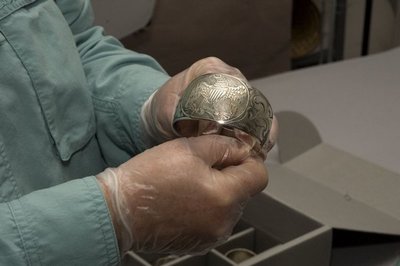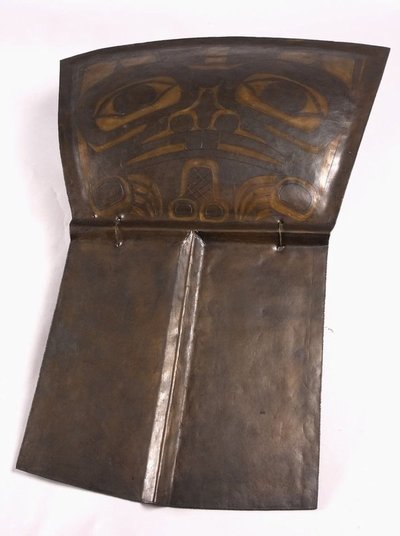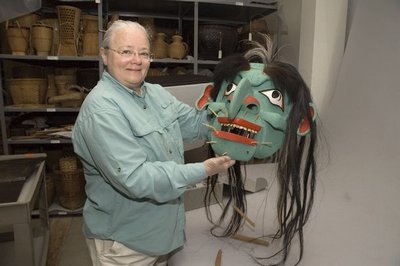May 4, 2006
Silver bracelets join strong Northwest Coast collection at the Burke
The Burke Museum recently received a donation of 30 silver bracelets made by Northwest Coast Native Americans. All but one of the bracelets were made in the late 19th and early 20th centuries — fashioned out of the silver dollars and half dollars that were the predominant currency at the time.
“Before this donation, I think we only had 15 silver bracelets, so it’s tripled our silver bracelet collection,” said Robin Wright, the Burke’s curator of Native American art. “We’re very pleased to have it. It fills out our collection.”
The bracelets were donated by Ruth Brink, the widow of Delbert Brink, who collected them in the 1970s and ’80s, and like many Burke donations, it came to the museum through a series of circumstances. Nancy Harris, a regular donor to the museum, had studied silver bracelets during her master’s program, so she knew about the Brink collection. When Delbert Brink died, Harris heard that Ruth Brink was considering selling the bracelets.
“Nancy told Ruth that the bracelets belonged in a museum, and offered to buy them herself to donate to the Burke,” Wright said. “Then Ruth said, ‘Well, why don’t I just donate them?'”
Silver bracelets, according to Wright, traditionally depicted crest animals that were symbols of heritage and status. In some native communities, crest animals were traditionally tattooed on the body, much to the disapproval of missionaries. When missionaries actively discouraged tattooing, the silver bracelet became an alternative outlet for representing one’s crest.
Some of the bracelets in the new collection, however, are adorned with the American eagle that appears on the silver dollar, or the artist has taken motifs from the original coin and incorporated them in his design.
The bracelets will take their place in the Burke’s extensive collection of Native American art, which is, according to Wright, one of the top five collections in the nation.
“We get the majority of our collection from donations,” she said. “We have limited funds from an endowment that will go to purchase collections. Some curators get to go to Sotheby’s and such but we don’t do that. So we really rely on our friends to think of us when they want to find a home for their collections.”
The Helen Hitchman collection, for example, came to the Burke when Hitchman simply decided it was time for a number of pieces that had been in her family to go to a museum.
Oftentimes, Wright said, the collector dies and the relatives don’t want the material, so they’ll call and ask if the museum wants it. “We have a major basket collection — more than 5,000 pieces (7,000 if you count non-Native American baskets) — because everybody finds baskets in their grandmother’s attic.”
Sometimes major donations can practically drop in the museum’s lap. Such was the case with the Arthur Steinman Sculpture Collection. Steinman lives in Florida, and had no connection to the UW or the Burke. But, after taking a cruise to the Northwest Coast, he began to collect contemporary Native American art, and by 2004 had hundreds of pieces in his collection.
When the collection grew too large for his condo, Steinman contacted a dealer in Vancouver from whom he had bought things. “He said he wanted to donate his collection and that he wanted it to go to a university or a research institution so that it could be seen and researched,” Wright said. “The dealer recommended the Burke.”
Steinman’s representative then came to the Burke with a few Polaroids of pieces from the collection. Wright told him the museum was interested, and a year later Steinman himself came for a tour of the facility. Still, Wright only saw Polaroids of the collection, so she flew to Florida to see it in person.
One look was enough to convince her that the Burke wanted the material. Steinman made the donation of 416 pieces, stipulating only that the museum pay the packing and shipping costs.
“It’s mostly big sculptures like masks and carved boxes, drums and argillite bowls and rattles.” (Argillite is a carved and polished carbonaceous shale that is found in a deposit in the Queen Charlotte Islands.)
The Steinman gift bolsters the contemporary portion of the Burke’s collection, which is now coming to balance their earlier collections. Sometimes the museum is even able to commission a work using endowment funds, usually to contribute to an exhibit.
Although space limitations keep much of the collection in storage, Wright said, the Web has been a boon to the Burke as many of the pieces can now be seen online. There are, for example, three views of each basket available — an overall view, a view of the rim and one of the start. Data on the dimensions and the materials are also included. So researchers can get a lot of information from afar. Still, nothing substitutes for seeing the material firsthand, and the Web can help there as well.
“What’s really useful is if researchers are planning a trip here, they can look at the collection on the Web and then send us a list of what they want to see,” Wright said.
And speaking of seeing, the additions to the bracelet collection will be on exhibit for the first time soon. They will be in the Burke’s lobby by June 7.





